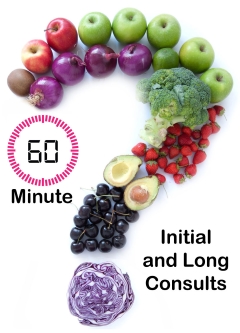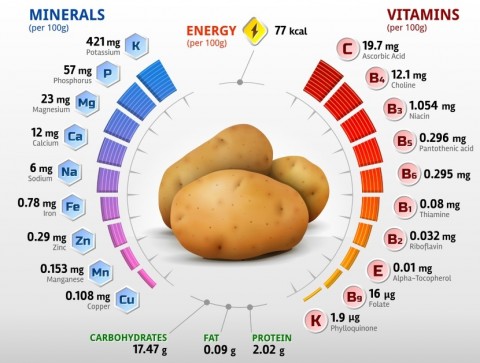DrCarney.com Blog
How to Eat a Balanced WFPB Diet
What is a balanced diet? A diet that supplies the proper proportions of all the nutrients necessary for health is considered a balanced diet. But despite our best efforts to eat healthfully, many of us worry that maybe we're not getting enough of certain nutrients. The entire supplement industry is largely built on that fear. But it's not a completely unrealistic worry. We know that deficiency of vitamin C causes scurvy; low vitamin D can cause rickets. While those diseases aren't threatening the population today as they have in the past, we do want to make sure that we are eating optimally for our health. So how can we be certain that we are meeting all of our nutritional needs? The answer is quite simple. If we are eating a variety of plant foods, and we are getting sufficient calories for energy and weight management, then our diet is balanced. No more worry.
Plant Foods in the Big Picture
In order for our body to be strong and healthy, we need macronutrients. These are the nutrients that our body needs in larger amounts — carbohydrates, protein, and fat. All plant foods have these. Let's look at how many grams of each macronutrient there are in a cup of the following foods:
Carbohydrates Protein Fat
Brown Rice 44.8 g 5 g 1.8 g
Pinto Beans 121 g 41 g 2.4 g
Green Peas 21 g 7.9 g .6 g
Sweet Potatoes 27 g 2.1 g .1 g
Spinach 1.1 g .9 g .1 g
Eggplant 4.8 g .8 g .1 g
Broccoli 6 g 2.6 g .3 g
Tomato 7 g 1.6 g .4 g
Apples 17 g .3 g .2 g
Mangos 25 g 1.4 g .6 g
Watermelon 11 g .9 g .2 g
Walnuts 14 g 15 g 65 g
Taking the Chart to Heart
Does this chart hold any surprises for you? All plant foods contain at least small amount of each macronutrient. Notice that even tomatoes have protein. And lettuce has a bit of fat. Plant foods really do have it all, but the proportions of their macronutrients are instructive. With the exception of walnuts, all the plant foods on this list have more carbs than any other macronutrient. That's typical of plant foods. Carbohydrates are the preferred source of calories for both our body and our brain. To keep up a steady supply of energy for mental and physical activity takes a lot of fuel, so the overwhelming majority of plant foods contain more carbs than any other macronutrient. Do you notice that (again, with the exception of walnuts) each of these plant foods has more protein than fat? That's because our body needs more protein than fat. We need protein to grow and repair the trillions of cells of our body as well as for other processes like synthesizing hormones. But we don't need protein in large amounts. Even babies — who double their weight in the first five months of life — need only five percent of their calories from protein; that's the percentage of protein in mother's milk. Sweet potatoes, for example, owe seven percent of their calories to protein. So, if we decided to go on a sweet potato-only diet, we'd still be getting more protein than our body requires. If we decided to get all our calories from broccoli, we'd get enough protein because 42 percent of broccoli's calories come from protein. And although we don't need much fat, our body does still require it. Fat is in the sheaths around our nerves and in the membranes around our cells. We need it for blood clotting and and for absorbing certain vitamins and minerals. But too much of it raises our cholesterol and damages the delicate lining of our arteries. That's why the overwhelming majority of plant foods were designed with only a little bit of fat — just enough to help us, not hurt us.
The chart shows, though, that there are some whole plant foods, such as walnuts, that are high in fat. Nuts, seeds, and foods such as avocados and olives are higher in fat. These foods are great condiments. A couple of olives with a meal, a small dollop of guacamole, or an ounce of nuts is all it takes to liven up dinner for a special occasion. If we compare how few high-fat plant foods there are in relation to the abundant variety of low-fat plant foods, we can take the hint. We were designed to eat a diet low in fat.
The Micronutrients in Plants
Plant foods are probably most famous for their micronutrients, the vitamins and minerals needed in relatively small quantities to support body functions. Plants are rich in vitamins because plants synthesize these substances to sustain their own growth; when we eat plants, we benefit from the vitamins the plants produced for their own purposes. Plant foods also contain minerals because the plant's root system takes them up from the soil. Some people worry that we may not be getting enough minerals because the soil is depleted. I like how John McDougall, MD, allays this fear of minerally-deficient soil. He says, "
Mineral deficiency is theoretically possible – but highly unlikely to affect anyone living in a modern society. ... deficiencies [in underdeveloped nations] occur because of the limited supply of foods for these people. They eat only foods grown in their local region, and the soil in their neighborhood may well be deficient in one of these minerals.
However, the risk of you suffering from vitamin or mineral deficiency caused by depleted soils is so incredibly small that a single case would make national headlines. This is simply because you eat foods grown from a wide variety of soils: corn grown in Nebraska soils, grapes from [Chile], bananas from Panama, etc. In the unlikely chance that one food was low in a mineral, your next bite would likely contain an abundant supply.
Abundance is exactly what plants offer. Just as all plants contain all three macronutrients, all plants offer multiple micronutrients. Kale, the darling of many nutritionists, has 19 different vitamins and minerals. But even the conservative potato has nine while strawberries have 12. Due to the variety of micronutrients available in each plant, we don't have to worry about becoming deficient as long as we fill our menu with a variety of plants.
'Phyt-ing' for Health in Living Color
The many colors of fruits and vegetables are an expression of their different nutritional profiles. In addition to macro- and micronutrients, plant foods contain phytonutrients, which give plants their vibrant hues. These colorful bits of nutrition are not essential for keeping our body alive, but they do help prevent disease and optimize our health. The orange color of carrots, for example, is due to the presence of carotenoids, phytochemicals that acts as antioxidants. Lycopene lends color to watermelon and tomatoes and has been linked to a lower risk of prostate cancer, plus it shows promise of helping to prevent heart disease. Anthocyanins are purple pigments found in grapes and berries; anthocyanins are thought to have antioxidant properties and to help boost the immune system. Eating a rainbow of plant foods each week ensures that we are getting a variety of vitamins, minerals, and disease-fighting phytonutrients.
The Vitamin D and B12 Exceptions
Plants were not designed to provide two of the vitamins necessary for our health. Vitamin D is actually a hormone which our own body synthesizes when sunlight hits our skin. Incidentally, if mushrooms are exposed to ultraviolet light, they also produce vitamin D; however, they aren't a reliable source because many commercial mushrooms are grown in the dark. But even if we ate a cup of wild mushrooms everyday, they would only supply about 12 percent of our daily needs. To know if we're spending enough time in the sun to make sufficient vitamin D, our doctor can order a blood test. If the test indicates we're deficient in this vitamin, we can supplement with a vegan form of vitamin D3. The other vitamin missing from plants is B12, which is produced by bacteria. Hydroxycobalamin is the B12 supplement I use to ensure adequate levels of this essential nutrient.
Eating for Balanced Nutrition, Energy, and Weight
Balancing a whole-food, plant-based diet is not tricky. Since plant foods abound in micronutrients and phytonutrients, and since they come prepackaged with the correct ratio of macronutrients, it's easy to get all the nutrition we need. If we are ensuring adequate levels of vitamins D and B12, then eating a reasonably varied diet of plant foods that includes vegetables, legumes, fruits, grains, and a few nuts and seeds is the only prerequisite for long-term nutrition on a low-fat, whole-foods, plant-based diet. Short term, history tells us that even very restricted plant-based diets can provide sufficient nutrition for robust health so long as starchy foods form the basis of the diet.
Since whole plant foods are designed to easily fulfill our nutritional needs, the only thing left for us to do is to make sure we're eating enough calories to supply our energy needs. My article What Does a Plant-Based Dinner Plate Look Like? offers suggestions on filling a plate that can keep us feeling satisfied and sustained. The secret to low-fat WFPB eating is a full stomach of low-calorie, whole plant foods that have enough calories from starch to provide energy until the next meal. If we don't fill up our stomachs at meal times or if we do not take in sufficient calories to sustain us, a feeling of hunger or a lack of energy will lead us to believe that a low-fat WFPB diet is "lacking."
Because there is such a wide variety of low-fat whole plant foods to choose from, most individuals have little problem eating plenty of food at mealtime and still managing their weight. However, some people do need to restrict lightly processed foods like bread or smoothies or to pay attention to portion control in order to achieve and maintain an optimum weight. Lindsay Nixon at HappyHerbivore.com offers perspective and help for individuals who struggle with weight even after their diet is 'perfect' by low-fat WFPB standards. Her own experience taught her that she needs to control her portions, and she has developed a plan to help others who need the same sort of help. But for the majority of individuals, simply filling up with lots of low-fat whole plant foods that have sufficient starch is all that is needed for weight control.
Addressing Concerns about Nutrition
Patients who ask me about the adequacy of a low-fat whole plant food diet are truly concerned about their health. Maybe they've tried "going vegan" before and felt it "just didn't work" for me them. Maybe they've been told that plants don't have enough protein or that they'll lack iron if they don't eat meat or that their bones will weaken without milk. Whenever I encounter a patient with these types of concerns, I try to listen carefully to determine exactly what is holding them back from grabbing the health offered by a diet of whole plant foods. Then, I answer their questions. I explain to them that starch has to form the basis of a plant-based diet in order for us to have enough calories for sustained energy. I tell them about the abundant protein in plants. I warn them of the risks of iron from meat. I point out that western cultures that eat a lot of dairy have higher rates of osteoporosis than societies which avoid dairy. Above all, I assure them that if they adopt a low-fat diet of whole plant foods, they will find a level of health that they didn't know was possible.
Vegetables, legumes, fruit, intact whole grains, and a few nuts and seeds form a balanced diet. As long as we ensure that we have adequate levels of vitamins D and B12, then eating low-fat whole plant foods can give us all the macronutrients we need for life, all the micronutrients we need for health, and all the phytonutrients we need to boost our body's ability to fight disease.
One Hour Phone Consult with Dr. Carney

Telephone Food Coaching Sessions with Linda Carney MD
Due to demand for nutritional advice, Dr. Carney's offers Starch-Smart® System "Dietary Care Extraordinaire" Food Coaching telephone sessions. The first sessions is always one hour. Subsequent sessions can be thirty minutes or one hour:
Click Here For 60 Minute Food Coaching Session
Please Note: Food Coaching sessions are not medical appointments and are not intended to replace your own physician. No tests will be ordered and no prescriptions will be provided.
Preview the "Perfect Health Requires Perfect Circulation" Trailer
Blood Flow Boosts Vitality: Do factors that affect artery linings create or ease your aches and pains? Explore the link between impaired circulation and health challenges. How does blood flow relate to health troubles? Learn how Dr. Carney's science-based Starch-Smart® System can improve your circulation and overall health by nourishing endothelial cells at the start of your day.
When you subscribe to the blog, we will send you an e-mail when there are new updates on the site so you wouldn't miss them.




